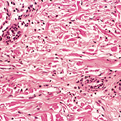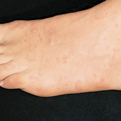Urticaria
General Information
Urticaria is the medical term for hives. Hives are very common skin condition with around 10-20 percent of the population having at least one episode in their lifetime. Urticaria is characterized by pruritic, raised, palpable lesions, which can be linear, circular, or serpiginous. The lesions can occur on any part of the body. Symptomatic lesions can last for about a few hours before going away and leave no trace behind. Information received by patients makes it easier to categorize the hives as acute, recurrent or chronic urticaria. Many hives are idiopathic; others may be triggered by medications including codeine, aspirin, morphine; food allergies; insect bites; occupational exposures; viral infections; hormonal causes and physical causes. The goal of treatment is to reduce the symptoms while the condition is self-limited. Antihistamines are the most commonly used medication, with the main effect being drowsiness. Topical therapies are also available to and reduce pruritus.
Epidemiology
15-25% of the population at some point in their lives
Etiology
Food allergies, drug allergies, environmental factors, emotional stress
Pathogenesis
Pruritus and skin lesions occur due to allergic or nonallergic mechanism
Clinical
Lesions, edematous pink or red, variable size and shape, with surrounding erythema
Histology
Sparse to moderately dense superficial and deep perivascular and interstitial mixed-cell infiltrate of lymphocytes, neutrophils, and eosinophils around venules, and neutrophils and eosinophils in the interstitium of the reticular dermis.
Bibliography
1. “Hives (Urticaria & Angioedema)” (Online). http://www.medicinenet.com/hives/article.htm (visited: April 4, 2008) 2. “Urticaria” (Online). November 2007. http://www.emedicine.com/med/TOPIC3014.HTM (visited: April 4, 2008)
Download PDF
![]() Urticaria
Urticaria


